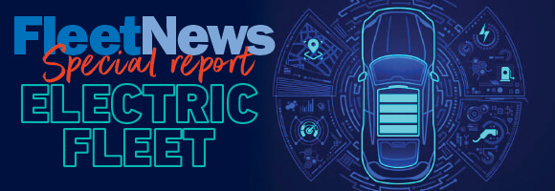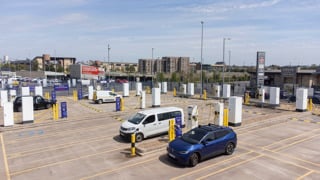This feature was taken from our latest Electric Fleet report. Click here to read it.

The long list of excuses for being late for a meeting, from traffic jams to train cancellations, now has a new, maybe more convincing addition – my electric vehicle (EV) failed to charge overnight.
Problems with plugging in or power tripping off can be a nuisance for anyone, but for mission-critical fleets they are a nightmare.
Any organisation needs to know that when its vehicles are plugged in at the office or depot, they are actually charging, so that when the cables are unplugged the vehicles are ready to go.
Experience, however, indicates that a potent cocktail of human error, hardware faults, power cuts or internet outages can interrupt charging and leave a vehicle unprepared for its next duty cycle.
As a result, fleet, facilities and transport managers need an aftercare solution to maintain chargers in serviceable condition and monitor chargers in real time, including overnight, so they can instantly spot and diagnose any faults that do occur and provide a swift fix.
After all, a charger that is out of action even for a couple of days could hamstring a business for that time.
The first step to 24/7 charger uptime occurs before a spade has even broken the ground to lay power cables, says Graham Rowlands, managing director of Devitech, which provides commercial EV charging installation, support and aftercare.
“Fleets need to make sure that when the infrastructure goes in, the number of chargers and specification are right for the site, particularly with power capacity. Issues occur if you try to overload a site or install too many chargers,” he adds.
Selecting robust chargers made by hardware manufacturers with a ready supply of replacement parts is also important, with infrastructure installers and maintenance companies advising fleet decision-makers to discuss the reliability of chargers with their peers.
Natasha Fry, head of sales at Mer Fleet Services, adds: “Choose hardware that is designed for a workplace environment – in a depot there are far more drivers plugging in, and there is the risk of vehicles bumping into chargers.”
The performance of chargers has improved enormously in recent years but, as with vehicles, not all hardware performs to the same standards and any initial savings from buying a poorer quality charger can soon evaporate in vehicle downtime and lost fleet productivity.
The other vital criterion when selecting chargers is to choose models that are Open Charge Point Protocol (OCPP) compliant, adds Fry.
Smart charging functionality
Since July 2022, the Government’s Smart Charging Regulations have made it compulsory for all home, workplace and commercial vehicle chargers sold in the UK to have ‘smart functionality’. This allows for charging when there is less demand on the grid, or when more renewable electricity is available.
More importantly for fleets, it ensures charge points have the ability to communicate and receive information, essential for the remote monitoring of chargers.
OCPP compliance ensures this back-office
monitoring can be done by any company, whereas a non-compliant charger might only be accessible to the hardware manufacturer.
“Invest in the right charger with OCPP functionality and then if you find you have appointed the wrong company to manage your back office, you can go out to the market and find a new back office,” says Fry.
Over-the-air updates
This connectivity matters enormously because it allows for over-the-air firmware updates and provides the foundations for the back office monitoring of chargers.
If there is an interruption to charging, some chargers can ‘self-fix’ minor issues, and, if this doesn’t work, they alert both fleet managers and charging solutions providers to attempt a remote fix.
“It has to be a proactive approach,” says Rowlands. “We typically know there’s an issue before the client does, we’ll fix it remotely, and then let the client know in the morning. We can do remote software updates, remote soft and hard resets, and unlock chargers.”
In many instances what appears to be a problem is simply a drop of Wi-Fi communication, with the charger still supplying power to a vehicle, but power outages can trip breakers and components do breakdown.
Charger aftercare solutions tend to bundle the remote monitoring of chargers with a maintenance package that sees engineers inspect hardware on a six-monthly or annual basis, paid for on a subscription-type fee per charger.
“Charging hardware has its own warranties, but service and maintenance is a separate package and is probably the most critical part of EV infrastructure at the moment because there’s a lack of supply,” says Tom Dinnage, head of sales, ElectrAssure.
“Too often, fleets have spent a lot of money on getting chargers installed and power in place, but don’t have a plan for when chargers don’t work.”
If remote fixes don’t do the job, ElectrAssure also offers bespoke Call Fix service level agreements (SLAs), which can be tailored to meet individual fleets’ specific response and resolution timeframes, dependent on their operational priorities.
“The most demanding SLA I have seen is a four-hour on-site response time for anywhere in the UK,” says Dinnage. More typical response time guarantees are three-to-five days.
First responders
Charging solution providers are also keen to train fleet and facilities managers to be ‘first responders’ in the case of a charger failing, with priority given both to the post-installation handover and to instructing drivers about how to charge safely and securely.
“We are putting chargers into Asda’s depots and we go along to their driver training sessions,” says Fry.
“They do the training with the EVs, and we link in with training them how to use the chargers.”
Finally, fleets need to have a Plan B ready in case a charger temporarily fails, with reliance on public charging hubs as a last resort.
Alternative solutions include specifying one or two more fast chargers than required, to act as spares; the installation of a more expensive rapid charger to deliver swift recharges in urgent cases; or the temporary use of a mobile charging unit, says Fry.
“Make sure you work with an organisation that understands the importance of high uptime and utilisation rates,” she adds.
“If something does go wrong – and remember, these are technical pieces of equipment so components will fail – what really counts is how that organisation reacts and whether it understands the importance of mission-critical vehicles so the service level can be delivered in line with expectations.”
Our latest Electric Fleet special report will help organisations take the next step to fully decarbonise their fleets, including:
- The new rules which slash EV charging infrastructure costs for fleets
- Importance of looking after charging cables
- Increase EV sustainability with a battery energy storage system
- Learnings from a wireless charging trial
- Electric vehicles coming soon





















Login to comment
Comments
No comments have been made yet.